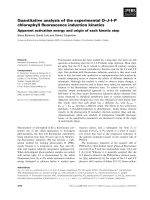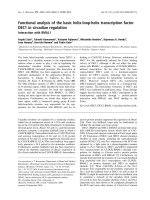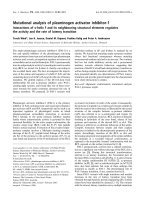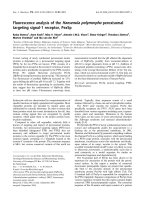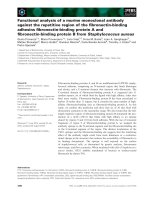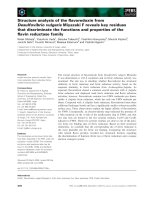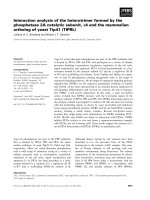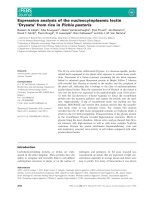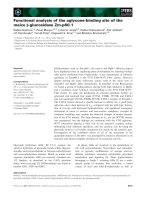Báo cáo khoa học: Interaction analysis of the heterotrimer formed by the phosphatase 2A catalytic subunit, a4 and the mammalian ortholog of yeast Tip41 (TIPRL) ppt
Bạn đang xem bản rút gọn của tài liệu. Xem và tải ngay bản đầy đủ của tài liệu tại đây (1.18 MB, 14 trang )
Interaction analysis of the heterotrimer formed by the
phosphatase 2A catalytic subunit, a4 and the mammalian
ortholog of yeast Tip41 (TIPRL)
Juliana H. C. Smetana and Nilson I. T. Zanchin
Center for Structural Molecular Biology, Brazilian Synchrotron Light Laboratory (LNLS), Campinas, Brazil
Type 2A phosphatases are part of the PPP subfamily
that is formed by PP2A, PP4 and PP6, the mam-
malian orthologs of yeast Pph21 ⁄ 22, Pph3 and Sit4,
respectively. These are serine ⁄ threonine phosphatases
with a wide range of substrates acting in a variety of
cellular processes such as transcription, translation,
regulation of the cell cycle, signal transduction and
apoptosis [1–4]. PP2A has been described as a holo-
enzyme formed by a catalytic (C), a regulatory (B, B¢
or B¢¢) and a scaffolding (PR65 ⁄ A) subunit [1–4].
Although dimers formed by AC subunits have been
described in vivo, the prevalent form of the PP2A
holoenzyme is the trimeric A:B:C complex. The num-
ber of B-type subunits is still growing with new
members continuously being discovered. The subunit
composition of the holoenzyme determines its subcel-
lular localization, activation state and substrate speci-
ficity [1–4]. PP4 forms either a heterotrimer with the
subunits PP4R2 and PP4R3 or a heterodimer with
PP4R1 [5], and specific subunits of PP6 (PP6R1,
Keywords
a4; rapamycin pathway; Tip41; type 2A
phosphatases; yeast two-hybrid system
Correspondence
N. I. T. Zanchin, Centro de Biologia
Molecular Estrutural, Laborato
´
rio Nacional
de Luz Sı
´
ncrotron, R. Giuseppe Ma
´
ximo
Scolfaro, 10.000, Campinas – SP,
PO Box 6192, CEP 13084-971, Brazil
Fax: +55 19 3512 1004
Tel: +55 19 3512 1113
E-mail:
(Received 7 June 2007, revised 25 August
2007, accepted 20 September 2007)
doi:10.1111/j.1742-4658.2007.06112.x
Type 2A serine ⁄ threonine phosphatases are part of the PPP subfamily that
is formed by PP2A, PP4 and PP6, and participate in a variety of cellular
processes including transcription, translation, regulation of the cell cycle,
signal transduction and apoptosis. PP2A is found predominantly as a het-
erotrimer formed by the catalytic subunit (C) and by a regulatory (B, B¢
or B¢¢) and a scaffolding (A) subunit. Yeast Tap42p and Tip41p are regula-
tors of type 2A phosphatases, playing antagonistic roles in the target of
rapamycin signaling pathway. a4 and target of rapamycin signaling pathway
regulator-like (TIPRL) are the respective mammalian orthologs of Tap42p
and Tip41p. a4 has been characterized as an essential protein implicated in
cell signaling, differentiation and survival; by contrast, the role of mamma-
lian TIPRL is still poorly understood. In this study, a yeast two-hybrid
screen revealed that TIPRL interacts with the C-terminal region of the
catalytic subunits of PP2A, PP4 and PP6. The TIPRL-interacting region on
the catalytic subunit was mapped to residues 210–309 and does not overlap
with the a4-binding region, as shown by yeast two-hybrid and pull-down
assays using recombinant proteins. TIPRL and a4 can bind PP2Ac simulta-
neously, forming a stable ternary complex. Reverse two-hybrid assays
revealed that single amino acid substitutions on TIPRL including D71L,
I136T, M196V and D198N can block its interaction with PP2Ac. TIPRL
inhibits PP2Ac activity in vitro and forms a rapamycin-insensitive complex
with PP2Ac and a4 in human cells. These results suggest the existence of a
novel PP2A heterotrimer (a4:PP2Ac:TIPRL) in mammalian cells.
Abbreviations
3-AT, 3-amino-triazol; GST, glutathione S-transferase; RBCC, ring finger B-box coiled coil; TIPRL, TOR signaling pathway regulator-like;
TOR, target of rapamycin.
FEBS Journal 274 (2007) 5891–5904 ª 2007 The Authors Journal compilation ª 2007 FEBS 5891
PP6R2 and PP6R3) have also been characterized
recently [6].
In addition to the regulatory and scaffolding sub-
units described above, mammalian type 2A phosphat-
ases share the a4 protein as a common regulator,
which binds directly to the catalytic subunits and
displaces other regulatory subunits [7–10]. a4, the
mammalian ortholog of yeast Tap42, was initially iden-
tified in association with the B-cell receptor Iga [11]
and has been implicated in the regulation of B- and
T-cell differentiation [12,13], vertebrate embryonic
development and cell death [14]. a4 was shown to inter-
act directly with the catalytic subunits of PP2A, PP4
and PP6 [10] and with the ring finger B-box coiled coil
(RBCC) proteins MID1 and MID2 [15,16], and has
also been found to participate in kinase ⁄ phosphatase
signaling modules with S6K [17] and CaCMKII [18].
These a4-containing complexes exemplify mechanisms
of PP2A regulation which are independent of the
canonical A and B regulatory subunits.
Type 2A phosphatases are key players in the yeast
target of rapamycin (TOR) signaling pathway [3].
Although Tap42 was characterized as a regulator of
the TOR pathway in yeast cells [19], the role of a4in
the mTOR-dependent control of cell growth is still
unclear. The yeast Tip41 protein was identified in a
yeast two-hybrid screen as a binding partner for Tap42
and genetic analyses suggested that it functions as a
negative regulator of the rapamycin-sensitive signaling
pathway by competing with Sit4 for Tap42 [20]. The
fission yeast homolog of Tip41 has been characterized
as a regulator of the activity of type 2A phosphatases,
possibly through its interaction with Tap42 [21]. There-
fore, characterization of TOR signaling pathway regu-
lator-like (TIPRL; TIP41), the mammalian ortholog of
Tip41, may provide clues to better understand the reg-
ulation of type 2A phosphatases and mTOR signaling.
In this study, starting from yeast two-hybrid analy-
ses, we identified the interaction of TIPRL with the
C-terminal region of the catalytic subunits of type 2A
phosphatases. TIPRL forms a heterotrimeric complex
with PP2Ac and a4 and does not compete with a4 for
PP2Ac binding, which contrasts with the model
described previously for their respective yeast ortho-
logs [20]. Reverse two-hybrid assays revealed that
single amino acid substitutions on TIPRL including
D71L, I136T, M196V and D198N can block its inter-
action with PP2Ac. TIPRL inhibits PP2A activity
in vitro and the PP2Ac ⁄ TIPRL complex is not affected
by rapamycin treatment of human cells. Our results
suggest that TIPRL, a4 and PP2Ac constitute a novel
heterotrimeric phosphatase holoenzyme.
Results
TIPRL interacts with the C-terminal region of the
catalytic subunits of type 2A phosphatases
A yeast two-hybrid screen using TIPRL as bait
revealed its interaction with the catalytic subunits of
type 2A phosphatases. A human leukocyte cDNA
library fused to the GAL4 activation domain of
pACT2 was screened using the yeast two-hybrid sys-
tem with TIPRL fused to lexA as bait. pACT2 was
rescued from 88 positive clones and the cDNAs were
identified by DNA sequencing. Ten cDNAs from the
88 positive clones encoded catalytic subunits of the
type 2A phosphatases PP2Aca (one cDNA), PP2Acb
(three cDNAs), the C-terminal region of PP2Aca ⁄ b
(one cDNA), PP4c (three cDNAs) and PP6c (two
cDNAs). Initial mapping of the region of PP2Ac
involved in TIPRL binding was obtained from the
cDNAs that showed positive interaction with TIPRL.
The extension of these cDNAs is shown in Fig. 1A.
Complete cDNAs were isolated only for PP2Aca and
PP2Acb. An additional PP2Acb cDNA was truncated
at residue 14. A fourth type of PP2Ac cDNA, encod-
ing residues from position 210 to the C-terminus,
may correspond to both PP2Aca and PP2Acb
because they show identical amino acid sequence in
this region. Two different cDNAs encoding PP4c
were isolated, including from residues 175 and 195 to
the C-terminus. The cDNAs encoding PP6c comprise
from residues 106 and 171 to the C-terminus, respec-
tively.
The interaction between TIPRL and the catalytic
subunit of type 2A phosphatases was verified by re-
transforming the prey plasmids into the L40 strain
containing plasmids pTL1-TIPRL encoding the lexA–
TIPRL fusion protein (Fig. 1B). This assay was per-
formed with the complete PP2Aca and PP2Acb
cDNAs, with the longest PP4c and PP6c cDNAs,
encompassing residues 175–307 and 106–305, respec-
tively, and the shortest cDNA, corresponding to the
C-terminal residues 210–309 of PP2Aca ⁄ b (named
PP2AcCT). As negative controls, the cDNA clones in
pACT2 were tested for self-activation using an unre-
lated bait (Nip7p). The interacting proteins Nip7p and
Nop8p were used as a positive two-hybrid control [22].
This assay confirmed the activation of HIS3 and lacZ
(not shown) expression in the clones containing lexA–
TIPRL and the catalytic subunit of the phosphatases
fused to the GAL4 activation domain (Fig. 1B), indi-
cating specific interactions between TIPRL and PP2A
catalytic subunits.
Identification of a novel PP2A heterotrimer J. H. C. Smetana and N. I. T. Zanchin
5892 FEBS Journal 274 (2007) 5891–5904 ª 2007 The Authors Journal compilation ª 2007 FEBS
The cDNAs of the phosphatase catalytic subunits
tested in the yeast two-hybrid system were subcloned
into the plasmid pGEX-5x2 in frame with glutathione
S-transferase (GST) and the resulting fusion proteins
were used to test their interaction with His–TIPRL
using recombinant proteins expressed in Escherichia
coli. In this experiment, His–TIPRL was pulled down
by all GST–phosphatase fusion proteins tested, but
not by GST alone (Fig. 2A). Residues 210–309 corre-
sponding to the C-terminal region of PP2Aca and
PP2Acb were sufficient for this interaction (Fig. 2A).
The interaction between recombinant PP2Aca and
endogenous TIPRL from HEK293 was tested in a
GST pull-down assay using glutathione–Sepharose-
immobilized GST–PP2Aca or GST and a HEK293 cell
extract. TIPRL was able to bind to GST–PP2Aca, but
not to GST alone, which further confirms the specific-
ity of this interaction (Fig. 2B).
Analysis of TIPRL protein expression by immunoblot
analysis identified similar levels in the immortalized cell
B
A
Fig. 1. TIPRL interaction with catalytic subunits of type 2A phosphatases in the yeast two-hybrid system. (A) Schematic representation of
the cDNAs encoding catalytic subunits of type 2A phosphatases isolated in the yeast two-hybrid screen using the TIPRL as bait. PP2Ac is
represented by a black bar for comparison. Numbers on the left of the gray bars indicate the first amino acid in the respective activation
domain-phosphatase catalytic subunit fusion. The PP2Ac isoforms a and b share identical amino acid sequences in the C-terminal region
comprising residues 210–309. (B) Two-hybrid assay for expression of the HIS3 reporter gene. Strain L40 carrying the yeast two-hybrid vec-
tors encoding the indicated DNA-binding domain (DB) and activation domain (AD) fusions were plated on synthetic minimal medium lacking
tryptophan and leucine (left, SD-WL) and, on minimal medium supplemented with 10 m
M 3-AT lacking tryptophan, leucine and histidine
(right, SD-WLH +10 m
M 3-AT). The phosphatase cDNAs fused to the activation domain were: PP2Aca and PP2Acb: full length, PP4c: resi-
dues 175–307, PP6c: residues 106–305 and PP2AcCT: residues 210–309. As negative controls, the activation domain-phosphatase cDNA
fusions were assayed in combination with pBTM-NIP7, encoding a DNA-binding domain fusion with an unrelated protein. Plasmids pBTM-
NIP7 (DB-NIP7) and pACT-NOP8 (AD-NOP8) were used as a positive control.
J. H. C. Smetana and N. I. T. Zanchin Identification of a novel PP2A heterotrimer
FEBS Journal 274 (2007) 5891–5904 ª 2007 The Authors Journal compilation ª 2007 FEBS 5893
lines HeLa, HEK293 and K562 (not shown). Cell frac-
tionation experiments showed that the subcellular distri-
bution of TIPRL in HEK293 cells was predominantly
cytoplasmic, coinciding with that of PP2Ac (Fig. 2C),
which further supports their functional relation. Inhibi-
tion of type 2A phosphatase activity by okadaic acid
treatment did not alter the subcellular distribution of
either TIPRL or PP2Ac (Fig. 2C).
Identification of TIPRL residues important for
interaction with PP2Aca
Analysis of the TIPRL amino acid sequence did not
reveal structural domains that could support a strategy
for construction of deletion mutants to map the
regions responsible for PP2Aca binding. Therefore, a
reverse two-hybrid approach was employed to find
interaction-deficient mutants of TIPRL that may pro-
vide information on the sites of interaction or contact
regions between TIPRL and PP2Aca. A PCR-based
random mutagenesis strategy [23] was used to generate
a library of mutant TIPRL cDNAs which was trans-
formed into strain L40 carrying pACT2–PP2Aca,
along with the linearized pTL1 vector in which the
region of the TIPRL cDNA comprising nucleotides
127–319 was removed. Recombination between a PCR
product and the remaining residues of the TIPRL
cDNA would reconstitute TIPRL coding sequence. As
G
S
T
-
P
P
2
A
c
α
α
α
α
GST-
PP2Acα
αα
α
Anti-
TIPRL
Anti-
GST
G
S
T
TIPRL
GST
Bound
I
n
p
u
t
DMSO OA
N
N
C
C
Anti-
TIPRL
Anti-
PP2Ac
TIPRL
PP2Ac
Anti-His
Coomassie
stained gel
PP2Acα
αα
α PP2Acβ
ββ
β
PP4c PP6c PP2AcCT
GST
GST fusion:
IB IB IB
IB IB IB
GST
PP2Acα
αα
α/β
ββ
β
PP4c
PP2AcCT
PP6c
GST fusion:
B
C
A
Fig. 2. Analysis of TIPRL interaction with catalytic subunits of type 2A phosphatases. (A) GST pull-down assay using recombinant proteins.
GST fusions of the indicated phosphatase catalytic subunits were coexpressed with His–TIPRL in E. coli. GST fusion proteins were isolated
from extracts by binding to glutathione–Sepharose beads. Bound proteins were resolved by SDS ⁄ PAGE and detected by immunoblotting
with the indicated primary antibodies or by Coomassie Brilliant Blue staining. The phosphatase cDNAs fused to GST were: PP2Aca and
PP2Acb: full length, PP4c: residues 175–307, PP6c: residues 106–305 and PP2AcCT: residues 210–309. His-tagged TIPRL copurified with
each one of the GST–phosphatase fusions but not with GST alone. (B) GST or GST–PP2Ac immobilized on glutathione–Sepharose beads
were incubated with HEK293 cell extracts and bound proteins were eluted by boiling in SDS ⁄ PAGE sample buffer. GST and TIPRL were
detected by immunoblot analysis. TIPRL was detected in association with GST–PP2Ac but not with GST alone. (C) Analysis of TIPRL subcel-
lular distribution. HEK293 cells were treated with 50 n
M of the PP2Ac inhibitor okadaic acid (OA) or with vehicle (dimethylsulfoxide) for 3.5 h
in serum-free medium and the nuclear (N) and cytoplasmic (C) fractions were separated and probed with specific antibodies. 7.5 lg of total
protein extract were loaded on each lane. Both TIPRL and PP2Ac are found predominantly in the cytoplasm and their subcellular distribution
was not affected by okadaic acid.
Identification of a novel PP2A heterotrimer J. H. C. Smetana and N. I. T. Zanchin
5894 FEBS Journal 274 (2007) 5891–5904 ª 2007 The Authors Journal compilation ª 2007 FEBS
a first step, the screen involved identification of inter-
action-deficient mutants as determined by loss of the
His3
+
phenotype and loss of activation of the lacZ
reporter gene. Subsequently, clones showing loss of
interaction were submitted to a round of immunoblot
analysis to exclude those that did not express the full-
length lexA–TIPRL fusion protein. Using these crite-
ria, 6 clones of 65 transformants tested were selected
for DNA sequencing analysis in order to identify the
mutations in the TIPRL cDNA. Each clone showed
single amino acid substitutions including D71L, Y79H,
I136T, M196V, D198N and Y214C. These clones were
retransformed into the L40 strain carrying plasmids
expressing activation domain fusions to full-length
PP2Aca, PP2Acb and PP4c and tested for the activa-
tion of the reporter gene HIS3 by growth on selective
medium lacking histidine and supplemented with
10 mm 3-amino-triazol (3-AT). This assay confirmed
loss of interaction for the mutants D71L, I136T,
M196V and D198N, whereas mutants Y79H and
Y214C still showed some activation of the reporter
gene (Fig. 3A). Similar results were obtained for the
three different catalytic subunits tested, which was
expected, because they should share an equivalent
interaction mechanism. Mutant Y79H behaved differ-
ently in this respect, because it appears to have a
reduced affinity for PP2Aca, but not for PP2Acb or
PP4c. Two independently isolated clones contained
mutations at very close positions (M196V ⁄ D198N),
strongly supporting the hypothesis that these residues
are located on TIPRL regions responsible for inter-
action with PP2Aca. In addition, a multisequence
alignment showed that residues D71, I136 and D198
corresponded to conserved positions on the TIPRL
sequence (Fig. 3B).
Ternary complex formation by TIPRL, PP2Ac
and a4
Because the yeast ortholog of TIPRL has been
described as a Tap42 interacting protein [20], it was
surprising that no cDNA encoding a4 was isolated in
the yeast two-hybrid screen using TIPRL as bait. Fur-
thermore, a direct assay using lexA–TIPRL and GAL4
activation domain-a4 in the yeast two-hybrid system
did not indicate an interaction between these two pro-
teins (data not shown). However, the identification
of type 2A phosphatase catalytic subunits as binding
partners for TIPRL suggested that TIPRL and a4
might be physically and functionally connected
through the type 2A phosphatase catalytic subunits.
GST pull-down assays were performed using E. coli
extracts containing His–a4, which were incubated with
GST–PP2Aca, GST–TIPRL or GST alone immobi-
lized on glutathione–Sepharose beads and extracts of
a coexpression assay containing His–a4 and His–
PP2Aca, which were incubated with GST–TIPRL
immobilized on glutathione–Sepharose beads. Under
these conditions, the association between His–a4 and
GST–TIPRL takes place only in the presence of His–
PP2Aca, clearly showing the existence of a ternary
complex involving these proteins (Fig. 4A). A second
experiment was performed in which a4 was fused to
GST and immobilized on glutathione–Sepharose
beads. As expected, His–TIPRL associated only with
GST–a4 in the presence of His–PP2Aca (data not
shown). Similar results were obtained using the
PP2Ac-binding domain of a4, a4D222 [24], instead of
the full-length protein (Fig. 4B), which further con-
firms that the TIPRL–a4 association is mediated by
PP2A and suggests that no direct interaction between
TIPRL and a4 is needed to stabilize this complex.
GST pull-down assays indicated that TIPRL and a4
bind simultaneously to PP2Ac. This was confirmed
using sequential binding experiments. Initially, GST–
PP2Aca was coexpressed with either His–TIPRL or
His–
a4 and the GST–PP2Aca:His–TIPRL and GST–
PP2Aca:His–a4 complexes were affinity-purified on
glutathione–Sepharose columns. Subsequently, the
GST–PP2Aca:His–TIPRL complex was incubated with
His–a4 and the GST–PP2Aca:His–a4 complex was
incubated with His–TIPRL. Binding of His–TIPRL to
the previously formed GST–PP2Aca:His–a4 complex
is shown in Fig. 4C. In the reciprocal experiment,
binding of His-a4 to the previously formed GST–
PP2Aca:His–TIPRL complex was also observed (data
not shown). Because of the lower levels of expression
of GST–PP2Aca relative to His–a4 or His–TIPRL, the
recovered dimeric complexes were stoichiometric, and
binding of the third protein without displacing the one
that was previously associated with the complex was
interpreted as an evidence of simultaneous binding to
PP2Aca.
The results of these in vitro binding experiments sug-
gested that although TIPRL and a4 do not interact
directly, they may be associated in vivo in a ternary
complex with PP2Ac. In agreement with this hypothe-
sis, a4 was specifically detected in TIPRL immunopre-
cipitates from HEK293 cell extracts (Fig. 4D). To
obtain further evidence on the TIPRL:PP2Ac:a4 asso-
ciation in vivo, HEK393 cell extracts were submitted to
gel-filtration chromatography and TIPRL, PP2Ac and
a4 were detected by western blotting (Fig. 4E). PP2Ac
elutes in two major peaks, one of which, with mole-
cular size in the range above 158 kDa, overlaps with
only a4, whereas the second overlaps with both a4 and
J. H. C. Smetana and N. I. T. Zanchin Identification of a novel PP2A heterotrimer
FEBS Journal 274 (2007) 5891–5904 ª 2007 The Authors Journal compilation ª 2007 FEBS 5895
B
A
Fig. 3. Yeast two-hybrid analysis of TIPRL interaction-deficient mutants. (A) L40 derivative strains containing pACT2-PP2Aca and the indi-
cated TIPRL mutant cDNAs fused to the lexA DNA-binding domain of pTL1 were plated on synthetic minimal medium lacking tryptophan
and leucine (upper panel, SD-WL) and, on minimal medium supplemented with 10 m
M 3-AT lacking tryptophan, leucine and histidine (lower,
SD-WLH +10 m
M 3-AT). TIPRL mutants D71L, I136T, T138S, M196V and D198N have lost or show reduced interaction with the catalytic
subunits of PP2Aca, PP2Acb and PP4c. Amino acid substitutions Y79H and Y214C have less pronounced effects on these interactions. (B)
Amino acid sequence alignment of TIPRL orthologs. Arrowheads indicate the amino acids that are substituted in TIPRL variants that have
lost interaction with PP2Ac in the yeast two-hybrid system. * and : indicate conserved residues and conserved amino acid substitutions,
respectively. Hsa, Homo sapiens; Xla, Xenopus laevis, Dre, Danio rerio; Dme, Drosophila melanogaster; Ath, Arabidopsis thaliana; Sce, Sac-
charomyces cerevisiae.
Identification of a novel PP2A heterotrimer J. H. C. Smetana and N. I. T. Zanchin
5896 FEBS Journal 274 (2007) 5891–5904 ª 2007 The Authors Journal compilation ª 2007 FEBS
His-PP2Acα
αα
α
GST-PP2Ac
C
GST-
PP2Acα
αα
α
His-TIPRL
IB
I
B
His-TIPRL
+
His- α
αα
α4
-
PP2Acα
αα
α
TIPRLGST
GST fusion
TIPRL
His-PP2Acα
αα
α
+
His-α
αα
α4 Δ
ΔΔ
Δ222
++++
IBIBIB
IB
His- α
αα
α4Δ
ΔΔ
Δ222
Coomassie
stained gel
His-PP2Acα
αα
α
α
αα
α
α
αα
α
B
GST
GST-TIPRL
GST-PP2Ac
D
α
αα
α4
*
Input
control
Anti-TIPRL
IP
TIPRL
*
Anti
- α
αα
α4
Anti-
TIPRL
E
158 kDa 66 kDa
123
A
GST-TIPRL
His- α
αα
α4
His- α
αα
α4
Coomassie
stained gel
Anti- α
αα
α4
GST
12345678
PP2Acα
αα
α
TIPRLGST
GST fusion
TIPRL
His-PP2Acα
αα
α
+
His-α
αα
α4
++++
IBIBIB
IB
[NaCl]
MWS
TIPRL
α
αα
α4
PP2Ac
Gel-filtration Ion exchange
Ion exchange
Fig. 4. Ternary complex formed by TIPRL, PP2Ac and a4. (A) GST, GST–TIPRL, GST–PP2Aca and His–a4 were expressed separately in
E. coli and His–PP2Aca was coexpressed with His–a4inE. coli. Bound proteins were resolved by SDS ⁄ PAGE and detected by immunoblot-
ting with an antibody for a4 or by Coomassie Brilliant Blue staining. His–a4 associated with GST–TIPRL only in the presence of His–PP2Aca.
GST and GST–PP2Aca were used as negative and positive controls, respectively; I: input; B: bound. (B) The experiment shown in (A) was
repeated using a C-terminal deletion of a4(a4D222) instead of full-length protein to show that only the PP2Ac-interacting domain of a4is
sufficient to assemble the ternary complex. (C) TIPRL does not compete with a4 for PP2Ac binding. GST–PP2Ac was coexpressed with
His–a4inE. coli and the complex was affinity-purified on glutathione–Sepharose beads. Samples of the complex incubated with recombinant
His–TIPRL (right) or of the control without His–TIPRL (left) were analyzed by SDS ⁄ PAGE (10%) and visualized by Coomassie Brilliant Blue
staining. TIPRL interacted with the PP2Ac:a4 complex previously formed. (D) In vivo association of TIPRL and a4. Endogenous TIPRL was
immunoprecipitated from HEK293 cell extracts and immunoprecipitates were probed with antibodies for TIPRL and a4. The * indicates stain-
ing of IgG heavy chain and is shown as a loading control. (E) The left panel shows western blot analyses of the elution profiles of PP2Ac,
TIPRL and a4 fractionated by gel filtration chromatography. MWM indicates the elution positions of molecular mass markers are shown
above the panels. The profiles of the three proteins overlap over a region that coincides with the expected molecular mass of the ternary
complex ( 110 kDa). The TIPRL peak fractions indicated in the bottom of the left panel were fractionated by ion exchange chromatography.
The elution profiles of PP2Ac, TIPRL and a4 from the ion-exchange chromatography are shown in the right panel. Only relevant fractions are
shown.
J. H. C. Smetana and N. I. T. Zanchin Identification of a novel PP2A heterotrimer
FEBS Journal 274 (2007) 5891–5904 ª 2007 The Authors Journal compilation ª 2007 FEBS 5897
TIPRL (Fig. 4E, left panel). The elution profiles of the
three proteins overlap in several fractions correspond-
ing to the expected molecular mass of a ternary com-
plex ( 110 kDa), which is in agreement with the
existence of such a complex in mammalian cells. The
TIPRL peak fractions from the gel-filtration chroma-
tography were further fractionated on an ion-exchange
column. The elution peaks of the three proteins corre-
spond to the same fractions, further indicating that
they are associated.
Regulation of PP2Ac activity by TIPRL
a4 has been characterized as a regulator of type 2A
phosphatases [7–9]. The finding that TIPRL interacts
with catalytic subunits of type 2A phosphatases sug-
gests that it might also directly regulate PP2Ac activ-
ity. In order to test this hypothesis, in vitro assays
were performed in which the activity of PP2A core
enzyme (A and C subunits) was measured in the pres-
ence of His–a4 or His–TIPRL using the phosphopep-
tide RRA(pT)VA as a substrate. Because His–a4 and
His–TIPRL are able to bind PP2Ac simultaneously,
the effect of both proteins was also assayed. Under
these conditions, His–a4 and His–TIPRL acted as
PP2A inhibitors, but no additive effect on PP2A inhi-
bition was observed in the presence of both His–a4
and His–TIPRL compared with the inhibitory effect of
each single protein (Fig. 5A).
To verify whether phosphatase inhibition was due
to occlusion of the active site, in vitro binding assays
were performed in the presence of the PP2Ac inhibi-
tor okadaic acid. These assays showed that binding
of His–TIPRL or His–a4 to GST–PP2Ac was not
affected by previous incubation of GST–PP2Ac with
okadaic acid (Fig. 5B,C), and also that okadaic acid
was not able to induce dissociation of the copurified
complexes His–TIPRL:GST–PP2Ac and His–a4:GST–
PP2Ac (data not shown). Previously reported okadaic
acid-induced dissociation of the a4:PP2Ac complex
[25] was interpreted as evidence that the binding site
for a4 might overlap the active site of the catalytic
subunit. However, the results obtained in this study
indicate that a4 and TIPRL are allosteric regulators
of PP2Ac rather than inhibitors, which is in agree-
ment with published observations showing that a4
binds PP2Ac on the surface opposite to the active site
[26], and that it has opposing allosteric effects on
PP2Ac and PP6c [27].
Rapamycin pathway-independent association of
TIPRL, PP2Ac and a4 in human K562 cells
Although in yeast Tap42 and type 2A phosphatases
are key players in the TOR pathway [19], the role of
a4 and PP2Ac in the mammalian rapamycin-sensitive
pathway remains controversial [7,8,9,14,25,28]. To test
TIPRL involvement in the mTOR pathway, a4or
PP2Ac were immunoprecipitated from K562 cell
extracts following rapamycin treatment. TIPRL coim-
munoprecipitated specifically with a4, which further
confirms the existence of a TIPRL:PP2Ac: a4 complex
in vivo (Fig. 6). However, none of the pairwise interac-
tions tested (PP2Ac:TIPRL, PP2Ac: a4, TIPRL:a4) was
affected by rapamycin treatment. These observations
support the existence of a TIPRL:PP2A:a4 hetero-
trimer in human cells, whose assembly is independent
of the mTOR signaling pathway (Fig. 6).
+
+
+
PP2Ac
+
His-TIPRL
+
+
His-α
αα
α4
-+- +
His-α
αα
α4
GST-PP2A
Anti-His
100
80
60
40
20
% control activity
0
Anti-GST
Input
Bound
+OA -OA
His-TIPRL
GST-PP2A
Anti-GST
+OA -OA
Anti-His
Input
Bound
A
C
B
Fig. 5. Regulation of PP2Ac by TIPRL and a4. (A) In vitro assay of PP2A core enzyme activity in the presence of purified His–TIPRL and ⁄ or
His–a4 using the Promega phosphatase assay system. Activities are expressed as a fraction of the positive control (without TIPRL and a4).
(B, C) PP2Ac interaction with TIPRL or a4, respectively, is not affected by okadaic acid treatment. GST–PP2Aca bound to glutathione–Sepha-
rose beads was incubated with okadaic acid (1 l
M) and His–TIPRL or His–a4. Bound proteins were resolved by SDS ⁄ PAGE (10%) and
probed with antibodies for the histidine and GST tags.
Identification of a novel PP2A heterotrimer J. H. C. Smetana and N. I. T. Zanchin
5898 FEBS Journal 274 (2007) 5891–5904 ª 2007 The Authors Journal compilation ª 2007 FEBS
Discussion
The interaction analyses presented in this study show
that TIPRL interacts specifically with the C-terminal
region of the catalytic subunits of type 2A phosphata-
ses. Residues 210–309 of PP2Ac are sufficient for inter-
action with TIPRL. The TIPRL region that interacts
with PP2Ac was investigated by using a reverse yeast
two-hybrid approach, which identified amino acid sub-
stitutions in four independently isolated mutants
(D71L, I136T, M196V and D198N) that block their
interaction with type 2A phosphatases. TIPRL shows a
subcellular distribution that coincides with PP2Ac in
human HEK293 cells and inhibits its activity in vitro.
Okadaic acid does not affect TIPRL interaction with
PP2Ac, suggesting that its binding surface on PP2Ac
does not involve the active site. These findings charac-
terize TIPRL as a novel allosteric regulator of type 2A
phosphatases, a role that has been attributed to date
only to the a4 protein. The fission yeast ortholog of
Tip41 was characterized as a regulator of type 2A phos-
phatases [21], which is in agreement with our results.
Because both TIPRL and a4 interact with the cata-
lytic subunits of type 2A phosphatases, we examined
the possibility of their simultaneous association, and
showed that TIPRL forms a ternary complex with a4
and PP2Ac in mammalian cells and that this complex
can be reconstituted in vitro from purified, recombi-
nant proteins. The 3D arrangement of the binding sites
for TIPRL and a4 on the surface of PP2Ac shows that
they are in close proximity, but not overlapping, which
allows the assembly of the TIPRL:PP2Ac:a4 complex
(Fig. 7A). Genetic mapping of the interaction sites
shows that a4 and TIPRL bind PP2Ac approximately
on the same regions as PR65 ⁄ A and B-type subunits,
respectively. a4 and PR65 ⁄ A bind to overlapping sites
on the surface of PP2Ac in a mutually exclusive fash-
ion, requiring complementary charged residues [26].
The a4-binding surface on PP2Ac was mapped to two
separated regions, comprising residues 19–22 and
150–164 [17], which are represented in blue in Fig. 7.
The interaction of PP2Ac with the regulatory B sub-
unit requires the extreme C-terminal region of the cat-
alytic subunit [29] and the interaction site for TIPRL
was mapped to the C-terminal third of PP2A, showing
that the TIPRL-binding region on PP2A is in close
proximity to, possibly overlapping, the B-subunit-
binding region. These similarities suggest that the
overall shape and subunit arrangement of the
TIPRL:PP2Ac:a4 complex might resemble that of
the canonical A:B:C complex, although their assembly
and regulation appear to be different. In the A:B:C
complex, the A subunit binds to C and enhances its
binding to B, whereas a4 and TIPRL appear to bind
PP2Ac independently. There is also no evidence of
physical contact between TIPRL and a4 in the ternary
complex, which contrasts with the existence of an A:B
interface [30,31].
Important differences between the yeast and mam-
malian models have been found. First, yeast Tip41 was
reported to compete with Sit4 for Tap42 binding [20],
whereas TIPRL and a4 can bind simultaneously to
PP2Ac. In addition, the rapamycin-insensitive assem-
bly of the TIPRL:PP2Ac:a4 complex also contrasts
with yeast studies [19] and with some studies involving
mammalian cells [7,8,14], although several studies have
already reported that rapamycin treatment has no
effect on the assembly of the PP2Ac:a4 complex
[9,25,28]. While this manuscript was in preparation,
similar observations were published by McConell et al.
[32] regarding the rapamycin-insensitive binding of
TIPRL to type 2A phosphatases. The effect of rapa-
mycin on the stability of these complexes might
depend on the cell line, because some cell lines are
more sensitive to rapamycin than others. The mTOR
C
B
A
WCE IP anti-PP2Ac
PP2Ac
α4
Anti-PP2Ac
Anti-α4
Rapa
-+ - +-
Rapa
TIPRL
PP2Ac
Anti-TIPRL
Anti-PP2Ac
-+ - +
WCE
IP anti- α4
Anti-α4
α4
-
WCE IP anti-TIPRL
PP2Ac
TIPRL
Anti-PP2Ac
Anti-TIPRL
Rapa
-+ -+
-
Fig. 6. Association of TIPRL, PP2Ac and a4 is not affected by rapa-
mycin treatment. K562 cells were treated with 200 n
M rapamycin or
dimethylsulfoxide for 3.5 h in serum-free medium (A) or in the pres-
ence of 10% fetal calf serum (B, C). TIPRL (A) PP2Ac (B) and a4 (C)
were immunoprecipitated from whole cell extracts (WCE), resolved
on SDS ⁄ PAGE (10%) and probed with antibodies for a4, PP2Ac and
TIPRL. The interactions PP2Ac:TIPRL (A) and PP2Ac:a4 (B), as well
as the PP2Ac-mediated TIPRL:a4 association (C) were specifically
detected and were not affected by rapamycin treatment.
J. H. C. Smetana and N. I. T. Zanchin Identification of a novel PP2A heterotrimer
FEBS Journal 274 (2007) 5891–5904 ª 2007 The Authors Journal compilation ª 2007 FEBS 5899
pathway is constitutively active in the K562 cell line
due to the expression of the BCR ⁄ Abl kinase, and this
cell line responds to rapamycin treatment by dephos-
phorylating the ribosomal protein S6 [33]. However,
no effect of rapamycin on the stability of the
TIPRL:PP2Ac:a4 complex was observed in this cell
line, although it cannot currently be ruled out that
rapamycin responsiveness is not at the level of complex
stability, but rather at the level of activity or substrate
specificity. The apparent discrepancies between studies
in yeast and mammalian cells indicate that the TOR
signaling pathway is not as conserved as previously
thought. Most probably, the TIPRL:PP2Ac:a4 com-
plex participates in other signaling pathways, including
the ataxia talangiectasia mutated ⁄ ataxia telangiectasia
and Rad-3-related (ATM ⁄ ATR) pathway [32], but its
targets remain to be identified.
In conclusion, our results show that TIPRL directly
binds the catalytic subunits of type 2A phosphatases,
but not a4, and that it regulates the activity of PP2A.
These findings contrast with the model proposed for
the yeast counterparts [20], but agree with recently
published studies involving the human proteins [5,32].
In addition to previous studies, we have mapped the
TIPRL-binding region on PP2Ac and identified some
of the residues on TIPRL which are responsible for
phosphatase binding. Finally, we report for the first
time the ternary association of PP2Ac, a4 and TIPRL.
Experimental procedures
Plasmid construction
A list of the plasmid vectors used in this work is found in
Table 1. The TIPRL cDNA (NM_152902) was amplified
from a fetal brain cDNA library (Clontech Laboratories,
Inc., San Diego, CA) and cloned into pTL1 (EcoRI–BamHI
sites), pET–TEV (NdeI–BamHI sites) and pET–GST–TEV
(NcoI–BamHI sites). pTL1, pET–TEV and pET–GST–TEV
are derivatives of pBTM116 and pET28a (Novagen, Darm-
stadt, Germany) that have been previously described [34].
pTL1–TIPRL encodes TIPRL containing an N-terminal
A
B
Fig. 7. PP2A catalytic subunit regions responsible for a4 and TIPRL binding. (A) The structure of PP2Aca downloaded from PDB (code 2IE3)
is shown in ribbon (left) and space filling models (right). The regions responsible for binding to a4 and to TIPRL1 are shown in blue and
violet, respectively. Residue Glu42 (yellow) is critical for interaction with a4 [26]. (B) Multiple sequence alignment of PP2A catalytic subunit
orthologs. * and : indicate conserved residues and conserved amino acid substitutions, respectively. Active site residues are colored red.
Identification of a novel PP2A heterotrimer J. H. C. Smetana and N. I. T. Zanchin
5900 FEBS Journal 274 (2007) 5891–5904 ª 2007 The Authors Journal compilation ª 2007 FEBS
lexA fusion and harbors the bacterial kanamycin marker.
pET–TIPRL and pET–GST–TIPRL encode N-terminal
hexahistidine and GST fusions, respectively, separated by a
TEV protease cleavage site. Construction of plasmids
pET28a–a4 and pET28a–a4D222 was described previously
[24]. To construct a plasmid encoding a GST–a4 fusion
protein, the cDNAs of GST, digested with XbaI–SalI, and
a4, digested with SalI–BamHI, were subcloned into the
plasmid pET29a (Novagen) previously digested with XbaI–
BamHI. The phosphatase cDNAs isolated from positive
two hybrid interactions were subcloned into the EcoRI and
XhoI sites of pGEX-5x2 (GE Healthcare, Piscataway, NJ).
The PP2Aca cDNA was also subcloned into pProEx HtB
(Invitrogen, Carlsbad, CA) using the same restriction sites.
Full-length PP4c cDNA was amplified from a human leu-
kocyte cDNA library and cloned into pACT2 between the
EcoRI and XhoI sites.
Yeast two-hybrid assays
Yeast two-hybrid screens were performed using yeast
strain L40 harboring plasmid pTL1–TIPRL. Expression of
the lexA–TIPRL fusion was verified by western blot with
an antibody for lexA (Invitrogen) and self-activation of
the reporter genes was tested with L40 strain transformed
with plasmids pTL1–TIPRL and pGAD424. Large- and
library-scale sequential transformations of L40 ⁄ pTL1–
TIPRL with a human leukocyte cDNA library cloned into
pACT2 (BD Bioscience Clontech) were performed using
the PEG ⁄ lithium acetate protocol as previously described.
Positive clones (His3
+
) were initially selected on SD-WLH
(synthetic complete medium lacking tryptophan; leucine
and histidine) supplemented with 5 mm 3-AT. Subse-
quently, His3
+
clones were subjected to a second round
of selection based on the activation of the reporter gene
lacZ, using X-Gal filter assays. The large-scale sequential
transformation yielded 54 positive clones from 4.5 · 10
4
clones tested and the library scale transformation yielded
1100 positive clones from 6.0 · 10
6
clones tested. Plasmid
pACT2 was rescued from 88 positive clones and the
TIPRL-interacting proteins identified by DNA sequencing
followed by BLAST analyses (.
gov/BLAST/).
Random mutagenesis and reverse two-hybrid
assays
A PCR-based random mutagenesis strategy [23] was used
to generate a library of mutant TIPRL cDNAs, using high
MgCl
2
concentrations (3 mm) to reduce DNA polymerase
fidelity. This library was transformed into L40 ⁄ pACT2–
PP2Aca strain along with pTL1–TIPRL linearized with
NdeI and the cotransformants were selected by plating on
SD-WL (synthetic complete medium lacking tryptophan
and leucine). Interaction-deficient mutants were selected by
replica plating on SD-WL and SD-WLH +10 mm 3-AT to
identify clones showing a His
–
phenotype. His
–
colonies
were subsequently tested for activation of the lacZ reporter
Table 1. Plasmid vectors used in this study.
Plasmid Relevant features Ref.
pTL1–TIPRL exADBD::TIPRL TRP1 2 lm This study
pACT2–PP2Aca GAL4AD::PP2Aca LEU2 2 lm This study
pACT2–PP2Acb GAL4AD::PP2Acb LEU2 2 lm This study
pACT2–PP2Acb (14–309) GAL4AD::PP2Acb(14–309) LEU2 2 lm This study
pACT2–PP4c (175–307) GAL4AD::PP4c(175–307) LEU2 2 lm This study
pACT2–PP4c (196–307) GAL4AD::PP4c(196–307) LEU2 2 lm This study
pACT2–PP6c (106–305) GAL4AD::PP6c(106–305) LEU2 2 lm This study
pACT2–PP6c (171–305) GAL4AD::PP6c(171–305) LEU2 2 lm This study
pACT2–PP2AcCT (210–309) GAL4AD::PP6c(210–309) LEU2 2 lm This study
pACT2–PP4c GAL4AD::PP4c LEU2 2 lm This study
pBTM116–NIP7 lexADBD::NIP7 TRP1 2 lm [22]
pGAD–NOP8 GAL4AD::NOP8 LEU2 2 lm [22]
pET28a–a4 His6:: a4, kan
R
[24]
pET28a– a4D222 His6:: a4D222, kan
R
[24]
pET–TIPRL His6::TIPRL, kan
R
This study
pProEx–PP2Aca His6::PP2Aca, amp
R
This study
pGEX)5X2 GST, amp
R
GE Healthcare
pGEX)5X2–PP2Aca GST::PP2Aca, amp
R
This study
pGEX)5X2–PP2Aca GST:: PP2Aca, amp
R
This study
pGEX)5X2–PP4c (175–307) GST::PP4c(175–307), amp
R
This study
pGEX)5X2–PP6c (106–305) GST::PP6c(106–305), amp
R
This study
pGEX)5X2–PP2AcCT (210–309) GST::PP2AcCT(210–309), amp
R
This study
pET–GST–TIPRL GST::TIPRL, kan
R
This study
J. H. C. Smetana and N. I. T. Zanchin Identification of a novel PP2A heterotrimer
FEBS Journal 274 (2007) 5891–5904 ª 2007 The Authors Journal compilation ª 2007 FEBS 5901
gene using an X-Gal filter assay. The colonies in which the
yeast two-hybrid markers were no longer activated were
tested for expression of the full-length TIPRL by western
blotting using an antibody for lexA (Invitrogen). Colonies
negative for two-hybrid interaction and expressing the full-
length lexA–TIPRL fusion protein were selected for further
analysis. The plasmid pTL1–TIPRL was rescued from these
strains and analyzed by DNA sequencing to identify the
amino acid substitutions that abrogate TIPRL–PP2Ac
interaction. Loss of interaction was confirmed by retrans-
forming pTL1 containing the mutant variants of TIPRL
into L40 strains carrying pACT2–PP2Aca, pACT2–
PP2Acb, and pACT2–PP24c.
GST pull-down assays
Bacterial cells [E. coli BL21(DE3)] were grown on Luria–
Bertani medium containing the appropriate antibiotics
at 50 lgÆmL
)1
and recombinant protein expression was
induced with 0.5 mm isopropyl thio-b-d-galactoside for
four hours at 25 °C. Bacterial pellets were suspended in ice
cold lysis buffer [NaCl ⁄ P
i
(140 mm NaCl, 2.7 mm KCl,
10 mm Na
2
HPO
4
, 1.8 mm KH
2
PO
4
), containing 0.5% Ige-
pal CA-630, 1 mm dithiothreitol and 1 mm phenylmethyl-
sulfonyl fluoride], treated with lysozime, sonicated and
centrifuged (20 000 g, 10 min, 4 °C). The supernates were
incubated with glutathione–Sepharose beads (GE Health-
care) for 30–60 min at 4 °C. Subsequently, the beads were
washed three times with ice-cold lysis buffer and bound
proteins were eluted with SDS ⁄ PAGE sample buffer. For
semi in vivo binding experiments, glutathione–Sepharose
beads containing GST–PP2Ac or GST were prepared as
above and, before elution in SDS ⁄ PAGE sample buffer, the
beads were incubated with HEK293 cell extracts for
30–60 min at 4 °C and washed three times with High Salt
Buffer (50 mm Tris ⁄ HCl pH 8.0, 250 mm NaCl, 0.5%
Igepal CA-630, 5 mm EDTA) supplemented with protease
inhibitors (Complete, EDTA-Free, Roche Molecular
Biochemicals, Indianapolis, IN).
Phosphatase assays
Activity of PP2A core enzyme (A and C subunits, Pro-
mega, Madison, WI) was assayed using the Serine ⁄ Threo-
nine Phosphatase Assay Kit (Promega) according to the
manufacturer’s instructions. The colorimetric measure-
ments were taken in an ELx 800 microplate reader (Bio
Tek Instruments, Winooski, VT) at 630 nm 0.5 units of
PP2A were assayed in triplicate in the presence of 25 ng
of His-tagged a4 and ⁄ or TIPRL, for 15 min at 30 °C.
His-tagged TIPRL was purified by affinity chromatogra-
phy on a Ni-NTA column (Qiagen, Valencia, CA), and
his-tagged a4 was purified as described previously [22].
TIPRL and a4 were quantified by direct absorbance at
280 nm.
Cell culture, fractionation and
immunoprecipitation assays
HEK293 and K562 cells were cultured in minimal essential
alpha medium supplemented with 10% fetal bovine serum,
with 100 UÆmL
)1
penicillin and 100 lgÆmL
)1
streptomycin
at 37 °C in a humidified atmosphere with 5% CO
2
. Total
cell extracts were prepared by suspending cells in high salt
buffer supplemented with protease inhibitors (Complete,
EDTA-Free, Roche) and NaF 50 mm. After 30 min on ice,
lysates were cleared by centrifugation (20 000 g, 10 min,
4 °C). Cytoplasmic fractions were obtained by suspending
cell pellets in low salt buffer (10 mm Tris ⁄ HCl pH 7.4,
320 mm sacarose, 2 mm MgCl
2
,3mm CaCl
2
, 0.4% Igepal
CA-630, 0.5 mm dithiothreitol) supplemented with protease
inhibitors (Complete, EDTA-Free, Roche) and centrifuging
at low speed (800 g, 5 min, 4 °C) after 10 min on ice.
Nuclear fractions were prepared from this low-speed centri-
fugation pellet as described above for total cell extracts.
Protein extracts were quantified using the BCA assay kit
(Pierce, Rockford, IL) and BSA as standard. Rabbit poly-
clonal antibodies for TIPRL (A300–663A), PP2Ac (A300–
732A) and a4 (A300–471A) were used in immunoprecipita-
tion assays, and antibody for murine MafB (A300–612A),
which does not recognize any protein in human cells, was
used as a negative control (Bethyl Laboratories, Montgom-
ery, TX). Protein extract (500 lg) was incubated with 1 lg
of antibody and Protein A–Sepharose beads (Pharmacia,
Uppsala, Sweden) for 3 h at 4 °C. The Protein A–Sepha-
rose beads were washed three times with ice-cold high salt
buffer and the bound proteins were eluted with
SDS ⁄ PAGE sample buffer. Western blots were performed
as described previously [35].
Gel-filtration and ion-exchange chromatography
of HEK293 cell extracts
HEK293 cells were suspended in High Salt Buffer supple-
mented with protease inhibitors (Complete, EDTA-Free,
Roche), incubated on ice for 30 min and sonicated. Cell
lysates were centrifuged at 20 000 g for 10 min at 4 °C and
the supernates were centrifuged at 100 000 g for 60 min at
4 °C. The supernate of the high-speed centrifugation (S100
extract) was loaded on a Superdex 200 16 ⁄ 60 column (GE
Healthcare) and isocratic elution was performed in high salt
buffer at 1 mLÆmin
)1
. The column was calibrated using fer-
ritin (440 kDa), aldolase (158 kDa), albumin (66 kDa) and
ribonuclease (13.7 kDa) and the void elution volume was
determined using blue dextran. Fractions from the gel filtra-
tion chromatography corresponding to the TIPRL elution
peak were dialyzed against ion exchange buffer A (50 mm
Tris ⁄ HCl pH 8.0, 50 mm NaCl, 5 mm EDTA, 0.1% Igepal
CA-630) for 16 h at 4 °C and fractionated on a Mono Q
column pre-equilibrated in the same buffer. The column
was washed with 10 mL of buffer A and proteins were
Identification of a novel PP2A heterotrimer J. H. C. Smetana and N. I. T. Zanchin
5902 FEBS Journal 274 (2007) 5891–5904 ª 2007 The Authors Journal compilation ª 2007 FEBS
eluted with a linear gradient of 0–100% buffer B (50 m m
Tris ⁄ HCl pH 8.0, 1 m NaCl, 5 mm EDTA, 0.1% Igepal
CA-630) in 15 mL at 1 mLÆ min
)1
. Chromatography was
performed on an A
¨
KTA FPLC (GE Healthcare).
Structural modeling and amino acid sequence
alignment
The coordinates of the PP2Aca structure were downloaded
from PDB (code 2IE3) and the figures generated using
PYMOL (). Multiple sequence align-
ment was performed with the clustalw algorithm (http://
www.ch.embnet.org/software/ClustalW.html).
Acknowledgements
We thank Tereza C. Lima Silva, Adriana C. Alves and
Zildene G. Correˆ a for technical support, and Carlos
R. C. Paier and Daniela S. Razolli for helping with
yeast reverse two-hybrid screening. JHCS was recipient
of CNPq fellowship. This work was supported by
FAPESP grant 06 ⁄ 02083-7 (NITZ) and the FAPESP
SMolBNet (00 ⁄ 10266-8) and CEPID⁄ CBME
(98 ⁄ 14138-2) programs.
References
1 Goldberg Y (1999) Protein phosphatase 2A: who shall
regulate the regulator? Biochem Pharmacol 57, 321–328.
2 Zolnierowicz S (2000) Type 2A protein phosphatase, the
complex regulator of numerous signaling pathways.
Biochem Pharmacol 60, 1225–1235.
3 Zabrocki P, Van Hoof C, Goris J, Thevelein JM, Wind-
erickx J & Wera1 S (2002) Protein phosphatase 2A on
track for nutrient-induced signalling in yeast. Mol
Microbiol 43, 835–842.
4 Cohen PT, Philp A & Vazquez-Martin C (2005) Protein
phosphatase 4 – from obscurity to vital functions. FEBS
Lett 579, 3278–3286.
5 Gingras AC, Caballero M, Zarske M, Sanchez A, Haz-
bun TR, Fields S, Sonenberg N, Hafen E, Raught B &
Aebersold R (2005) A novel, evolutionarily conserved
protein phosphatase complex involved in cisplatin sensi-
tivity. Mol Cell Proteomics 4, 1725–1740.
6 Stefansson B & Brautigan DL (2006) Protein phospha-
tase 6 subunit with conserved Sit4-associated protein
domain targets IjBe. J Biol Chem 281, 22624–22634.
7 Murata K, Wu J & Brautigan DL (1997) B cell recep-
tor-associated protein a4 displays rapamycin-sensitive
binding directly to the catalytic subunit of protein phos-
phatase 2A. Proc Natl Acad Sci USA 94, 10624–10629.
8 Inui S, Sanjo H, Maeda K, Yamamoto H, Miyamoto E
& Sakaguchi N (1998) Ig receptor binding protein 1
(a4) is associated with a rapamycin-sensitive signal
transduction in lymphocytes through direct binding to
the catalytic subunit of protein phosphatase 2A. Blood
92, 539–546.
9 Nanahoshi M, Nishiuma T, Tsujishita Y, Hara K, Inui
S, Sakaguchi N & Yonezawa K (1998) Regulation of
protein phosphatase 2A catalytic activity by a4 protein
and its yeast homolog Tap42. Biochem Biophys Res
Commun 251, 520–526.
10 Nanahoshi M, Tsujishita Y, Tokunaga C, Inui S, Sak-
aguchi N, Hara K & Yonezawa K (1999) a4 protein as
a common regulator of type 2A-related serine ⁄ threonine
protein phosphatases. FEBS Lett 446, 108–112.
11 Kuwahara K, Matsuo T, Nomura J, Igarashi H,
Kimoto M, Inui S & Sakaguchi N (1994) Identification
of a 52-kDa molecule (p52) coprecipitated with the Ig
receptor-related MB-1 protein that is inducibly
phosphorylated by the stimulation with phorbol
myristate acetate. J Immunol 152, 2742–2752.
12 Inui S, Maeda K, Hua DR, Yamashita T, Yamamoto
H, Miyamoto E, Aizawa S & Sakaguchi N (2002) BCR
signal through a4 is involved in S6 kinase activation
and required for B cell maturation including isotype
switching and V region somatic hypermutation. Int
Immunol 14, 177–187.
13 Hua DR, Inui S, Yamashita T, Maeda K, Takagi K,
Takeda J & Sakaguchi N (2003) T cell-specific gene tar-
geting reveals that a4 is required for early T cell devel-
opment. Eur J Immunol 33, 1899–1906.
14 Kong M, Fox CJ, Mu J, Solt L, Xu A, Cinalli RM,
Birnbaum MJ, Lindsten T & Thompson CB (2004) The
PP2A-associated protein a4 is an essential inhibitor of
apoptosis. Science 306, 695–698.
15 Liu J, Prickett TD, Elliott E, Meroni G & Brautigan
DL (2001) Phosphorylation and microtubule association
of the Opitz syndrome protein mid-1 is regulated by
protein phosphatase 2A via binding to the regula-
tory subunit a4. Proc Natl Acad Sci USA 98, 6650–
6655.
16 Trockenbacher A, Suckow V, Foerster J, Winter J,
Krauss S, Ropers HH, Schneider R & Schweiger S
(2001) MID1, mutated in Opitz syndrome, encodes an
ubiquitin ligase that targets phosphatase 2A for degra-
dation. Nat Genet 29, 287–294.
17 Yamashita T, Inui S, Maeda K, Hua DR, Takagi K &
Sakaguchi N (2005) The heterodimer of a4 and PP2Ac
is associated with S6 kinase1 in B cells. Biochem Biophys
Res Commun 330, 439–445.
18 Yamashita T, Inui S, Maeda K, Hua DR, Takagi K,
Fukunaga K & Sakaguchi N (2006) Regulation of
CaMKII by a4 ⁄ PP2Ac contributes to learning and
memory. Brain Res 1082, 1–10.
19 Di Como CJ & Arndt KT (1996) Nutrients, via the Tor
proteins, stimulate the association of Tap42 with type
2A phosphatases. Genes Dev 10, 1904–1916.
J. H. C. Smetana and N. I. T. Zanchin Identification of a novel PP2A heterotrimer
FEBS Journal 274 (2007) 5891–5904 ª 2007 The Authors Journal compilation ª 2007 FEBS 5903
20 Jacinto E, Guo B, Arndt KT, Schmelzle T & Hall MN
(2001) TIP41 interacts with TAP42 and negatively regu-
lates the TOR signaling pathway. Mol Cell 8, 1017–
1026.
21 Fenyvuesvolgyi C, Elder RT, Benko Z, Liang D &
Zhao RY (2005) Fission yeast homologue of Tip41-like
proteins regulates type 2A phosphatases and responses
to nitrogen sources. Biochim Biophys Acta 1746, 155–
162.
22 Zanchin NI & Goldfarb DS (1999) Nip7p interacts with
Nop8p, an essential nucleolar protein required for 60S
ribosome biogenesis, and the exosome subunit Rrp43p.
Mol Cell Biol 19, 1518–1525.
23 Zhou Y, Zhang X & Ebright RC (1991) Random muta-
genesis of gene-sized DNA molecules by use of PCR
with Taq DNA polymerase. Nucleic Acids Res 19, 6052.
24 Smetana JH, Oliveira CL, Jablonka W, Aguiar Perti-
nhez T, Carneiro FR, Montero-Lomeli M, Torriani I &
Zanchin NI (2006) Low resolution structure of the
human a4 protein (IgBP1) and studies on the stability
of a4 and of its yeast ortholog Tap42. Biochim Biophys
Acta 1764, 724–734.
25 Kloeker S, Reed R, McConnell JL, Chang D, Tran K,
Westphal RS, Law BK, Colbran RJ, Kamoun M,
Campbell KS et al. (2003) Parallel purification of three
catalytic subunits of the protein serine ⁄ threonine phos-
phatase 2A family (PP2A(C), PP4(C), and PP6(C)) and
analysis of the interaction of PP2A(C) with a4 protein.
Protein Expr Purif 31, 19–33.
26 Prickett TD & Brautigan DL (2004) Overlapping bind-
ing sites in protein phosphatase 2A for association with
regulatory A and a-4 (mTap42) subunits. J Biol Chem
279, 38912–38920.
27 Prickett TD & Brautigan DL (2006) The a4 regulatory
subunit exerts opposing allosteric effects on protein
phosphatases PP6 and PP2A. J Biol Chem 281, 30503–
30511.
28 Chen J, Peterson RT & Schreiber SL (1998) a4 associ-
ates with protein phosphatases 2A, 4, and 6. Biochem
Biophys Res Commun 247, 827–832.
29 Ogris E, Gibson DM & Pallas DC (1997) Protein phos-
phatase 2A subunit assembly: the catalytic subunit
carboxy terminus is important for binding cellular B
subunit but not polyomavirus middle tumor antigen.
Oncogene 15, 911–917.
30 Xu Y, Xing Y, Chen Y, Chao Y, Lin Z, Fan E, Yu
JW, Strack S, Jeffrey PD & Shi Y (2006) Structure of
the protein phosphatase 2A holoenzyme. Cell 127,
1239–1251.
31 Cho US & Xu W (2007) Crystal structure of a protein
phosphatase 2A heterotrimeric holoenzyme. Nature 445
(7123), 53–57.
32 McConnell JL, Gomez RJ, McCorvey LR, Law BK &
Wadzinski BE (2007) Identification of a PP2A-interact-
ing protein that functions as a negative regulator of
phosphatase activity in the ATM ⁄ ATR signaling path-
way. Oncogene 26, 6021–6030.
33 Ly C, Arechiga AF, Melo JV, Walsh CM & Ong ST
(2003) Bcr-Abl kinase modulates the translation regula-
tors ribosomal protein S6 and 4E-BP1 in chronic mye-
logenous leukemia cells via the mammalian target of
rapamycin. Cancer Res 63, 5716–5722.
34 Carneiro FR, Silva TC, Alves AC, Haline-Vaz T, Gozzo
FC & Zanchin NI (2006) Spectroscopic characterization
of the tumor antigen NY-REN-21 and identification of
heterodimer formation with SCAND1. Biochem Biophys
Res Commun 343, 260–268.
35 Ausubel FM, Brent R, Kingston R, Moore DD, Seid-
man JG, Smith JA & Struhl K (1998) Current Protocols
in Molecular Biology. Wiley, New York.
Identification of a novel PP2A heterotrimer J. H. C. Smetana and N. I. T. Zanchin
5904 FEBS Journal 274 (2007) 5891–5904 ª 2007 The Authors Journal compilation ª 2007 FEBS

